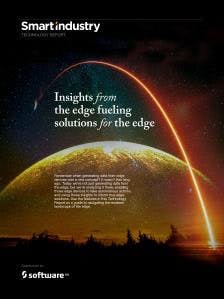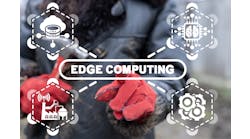By Jonathan Weiss, Software AG vice president of emerging technologies
The Internet of Things has opened a wide door to businesses that want instant insights into data to
This feature is from our July Tech Report on edge solutions. Click the cover to get your copy.
operate smarter, competitively and differently than ever before. Companies capitalizing on this shift are known as “digital disruptors.” According to IDC, only 5% of companies have achieved digital-disruptor status. That leaves a gigantic 95% as “disrupted”—probably not the ideal place to be.
Let’s find your “edge”
Emerging technologies in the IoT and IIoT space, such as edge computing, are helping companies of every size and vertical to successfully convert into digital disruptors. Shifting to an on-premises approach with edge computing brings you closer to the data generation source—and that offers distinct advantages.
With IoT edge computing, you can:
- Reduce the cost of sending lots of data to the cloud
- Optimize operations immediately by analyzing and acting on data locally and in real time
- Eliminate latency in decision making by bringing the asset as close as possible
- Prevent connectivity gaps by removing the time it takes for decisions in the cloud to reach an asset with a command and signal
In short, operations run faster. Decisions are made faster with the latest data. Your business becomes more agile, responsive and efficient. That’s a great place to be.
5 steps to disruption
Step 1: Fuse your fractured enterprise
Two factions within any organization drive decision making: business and IT. While both parties share a common interest to keep stakeholders happy, their primary goals and responsibilities often compete. Business is focused on developing new business models, market adaptation and revenue growth. IT, on the other hand, is homed in on governance, modernization and cost reduction. These conflicts of interest create a fractured enterprise, and these conflicts are why only 5% of companies become digital disruptors. That 5% has the tools to fuse the fractured enterprise; they work collaboratively and cohesively together, creating the truly connected enterprise.
Step 2: Free siloed data
Once business and IT are in sync, you’re set to create a connected and data-driven business. Integration of all systems is the key, enabling you to free siloed data and give everyone access to it, the space to operationalize it and put it to work. With access to all your enterprise data, including data in core systems and real-time data from the IoT, people across your business can use the latest and most complete data to innovate, improve the customer experience, and transform your business.
Step 3: Build solutions on the IoT
The Internet of Things makes you a disruptor in three ways:
1. The IoT reduces costs and increases business continuity by enabling you to predict when repairs will be needed and fix them before production problems occur. You can use the IoT to remotely monitor and control assets as well as increase their lifespan, creating the notion of a hassle-free process. Effective asset management means remotely diagnosing problems and troubleshooting right away—rather than rolling out a service truck to the scene every time a problem is detected.
2. The IoT engages customers in a way that gives your business a better understanding of how customers interact with the goods and services you provide. The IoT data you collect can provide insight into the behavioral relationship your customers have with your goods and services. You can use that data to enhance the customer experience. You’ll also be able to identify processes to evolve to strengthen relationships with customers, so they’ll want to buy more from you.
3. The IoT increases sales and revenue by enabling you to offer “products-as-a-service.” You can transform physical products (let’s say printers) into smart connected products (printers offered with subscription services where, automatically, ink is ordered, or technicians are called for repairs before equipment breaks).
Step 4: Overcome barriers to entry
When adopting IoT at the edge, be aware of barriers that could keep you from reaching your goals. One barrier is the deployment constraints of an existing architecture. Edge analytics requires on-premises infrastructure and is generally overseen by IT. An enterprise that doesn’t include IT in the ideation phase could overlook the important physical constraints of where to put things.
Continuous connectivity is another potential pitfall. Maybe you’re in a location that does not communicate with the outside world; you have poor cell signal, you have unreliable internet connection, or internet connections are costly. These are actually reasons to move toward edge computing as long as you maintain a distributed architecture.
Step 5: Invest in streaming analytics
Because it’s expensive to send large amounts of data to the cloud, streaming analytics and AI are especially valuable at the edge; they go hand in hand.
So, when choosing a solution for streaming analytics, make sure it’s really “real time” so you can act on insights when they matter. Ask:
- Will analytics be accessible to a wide range of people in your organization?
- Will you need to manually push a software configuration or a firmware update to the edge?
- Will you be able to plug into a data capture pipeline to reduce latency of actionable insights?
- Will you be able to connect third-party products that benefit the rest of the business?
- Will you have full control of the device from a support and management perspective?
- Will you need an army of software engineers to architect and build your analytics solution?
Meet real-world disruptors
Digital disruptors are using the IoT to do everything from remotely managing conveyor belts to checking inventory on industrial machines to monitoring water meters. Here are a few companies Software AG has helped to join the 5%. They’re booming on the IoT:
Dürr, a manufacturer of robots that paint cars, leverages Software AG’s IoT solution to create predictive algorithms using data from the robots. By introducing edge computing and analytics, Dürr does real-time data assessments of the painting robots and adjusts paint mixtures immediately. This increases the quality of paint jobs and reduced paint consumption dramatically—by 50% per car!
A company that builds and distributes wind turbines, generating power across nearly 6,000 wind turbines, uses Cumulocity IoT. The company connects these assets at the edge and manages information on the variants right in the control box of each wind turbine. Only critical bytes and bits are sent on to the cloud and a data center, reducing bandwidth costs.
Cruise ships use Software AG’s IoT and analytics capabilities to monitor guests in real time. They can see whether a passenger has left the ship, fallen overboard or been left behind at a port of call. Cumulocity IoT at the edge helps the cruise line see, act and decide on guests “virtually” to improve their safety. This is done at the edge, because ships may be out of range of a central data warehouse or the cloud.
Collecting and analyzing data from connected “things”—at the edge or anywhere—enables you to further automate your operations for peak performance. The opportunities to optimize your business on the IoT are endless—and essential to your transformation into a digital disruptor.




